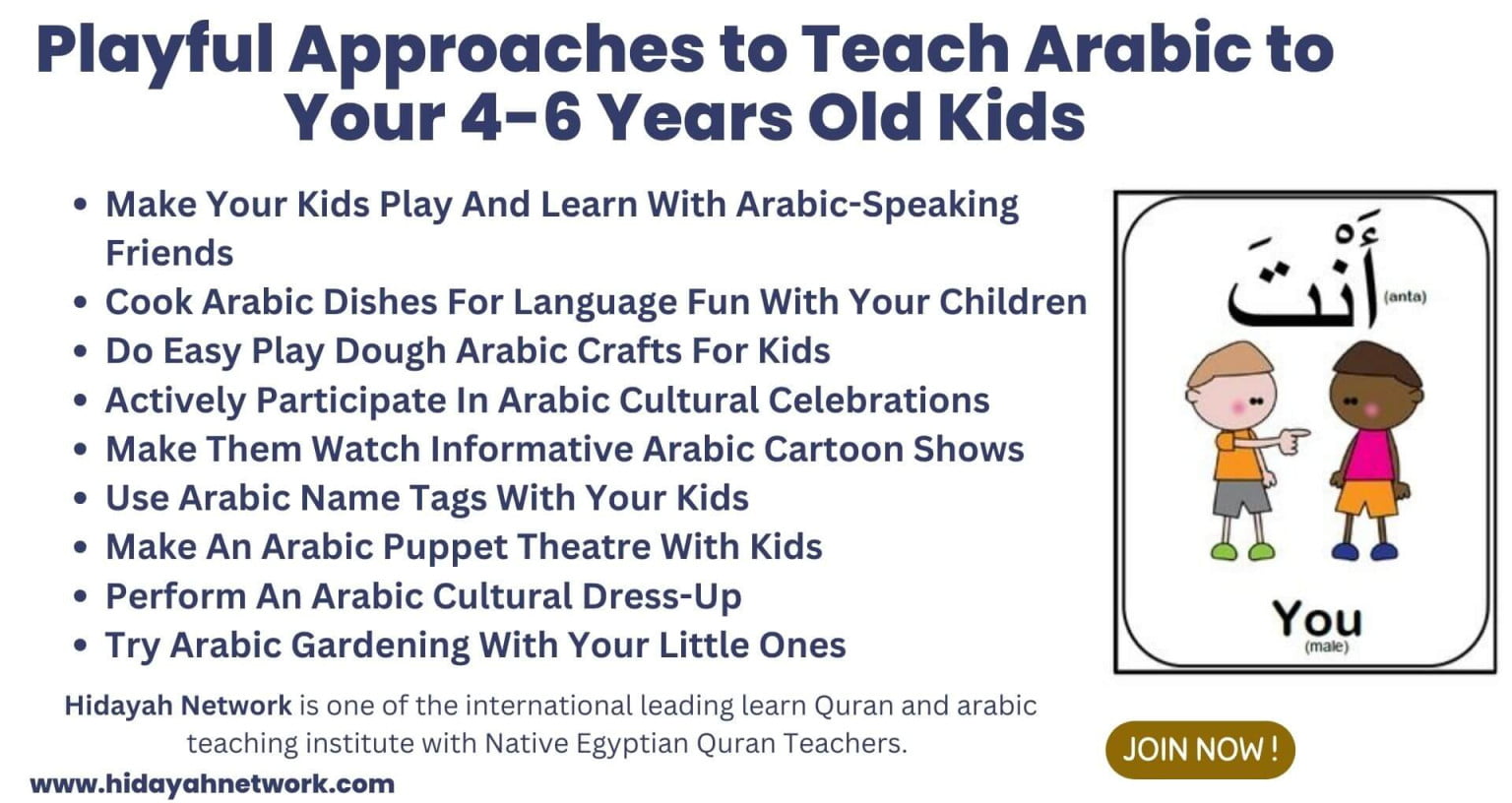Teaching Arabic to 3-6-year-olds kids can be a fun and exciting experience for parents. It’s the right time to set a solid foundation that can help in learning the Quran for the future. Thankfully, there are practical ways that can help you ensure your 3 year old learns Arabic basic perfectly well in the beginning.
Start doing Arabic calligraphy with finger painting with your kid, engage in building block of Arabic letters, introduce your kid to other Arabic-speaking kids, let your kid participate in Arabic cultures and events, and so on. There are many more exciting and playful activities that your kid will find highly interested when learning Arabic for the first time. Let’s learn more in detail here!
Table of Contents
Toggle12 Playful Approaches to Teach Arabic to Your 4-6 Years Old Kids
Let’s explore 8 interactive approaches for teaching Arabic to your kids and make learning enjoyable.
1. Do Arabic Calligraphy with Finger Painting with Kids
Introduce the beauty of Arabic letters through a fun and creative activity like finger painting. Encourage children to explore the curves and lines of each letter in a playful manner. Make the learning process enjoyable and interactive.
To-Do List
- Provide Arabic letter templates for guidance.
- Use vibrant, washable finger paints for mess-free fun.
- Celebrate each letter creation with praise.
2. Engage in Arabic Letter Building Blocks
Transforming Arabic learning into a hands-on adventure, utilize vibrant Arabic letter building blocks to captivate young minds. Each block becomes a tangible exploration of letters, fostering a connection between shapes and sounds.
- Collaborate with the little ones to construct simple words, encouraging teamwork and reinforcing the understanding of letter combinations.
- Celebrate their achievements with positive affirmations, turning the learning process into a joyful and rewarding experience.
With these blocks, the world of Arabic letters becomes a colorful playground where education and play seamlessly intertwine.
3. Arabic Countdown to Bedtime
Infuse the bedtime routine with a touch of Arabic magic by incorporating a countdown. Half an hour before bedtime, start the enchanting journey using Arabic numbers.
As the numbers dwindle, create a tranquil atmosphere by introducing bedtime stories in Arabic, immersing the children in the soothing flow of the language.Expert Tip: Enhance the experience by implementing a bedtime sticker chart to acknowledge their successful day of learning. This simple yet effective approach effortlessly integrates Arabic into the daily routine, making bedtime a cherished moment of linguistic discovery and relaxation.
Get 40% OFF Now!
4. Make Your Kids Play And Learn With Arabic-Speaking Friends
Encouraging your kids to play and learn with Arabic-speaking friends can be incredibly beneficial. They can learn with a group of friends in online Arabic classes for kids.
Immersing them in an environment where they interact with native speakers can help them pick up the language naturally. For instance, simple words like “ألوان” (colours) or “أصدقاء” (friends) can become part of their vocabulary during playdates.
These interactions not only foster language skills but also promote cultural understanding.
Imagine your child playing games like “تُخبِئ وتَبحث” (hide and seek) with their Arabic-speaking friends. They not only have fun but also absorb Arabic words effortlessly.
So, encourage these interactions as they provide a dynamic way for your kids to embrace Arabic and create lasting friendships
5. Cook Arabic Dishes For Language Fun With Your Children
Exploring the world of Arabic cuisine with your children is an enjoyable way to introduce them to the language. As you prepare dishes like falafel or kabsa, you can introduce them to new Arabic words while having fun in the kitchen.
For example, when making tahini sauce, you can teach them the word for “sesame” in Arabic, expanding their vocabulary while enjoying a delicious meal. It’s a flavorful way to bond with your child while nurturing their love for the Arabic language.
Important Tip: When making tahini sauce, you can teach them the word for “sesame” in Arabic, expanding their vocabulary while enjoying a delicious meal.
6. Do Easy Play Dough Arabic Crafts For Kids
Unleash creativity with simple play dough Arabic crafts! Mold Arabic letters and shapes using vibrant play dough, making learning a hands-on delight. Reinforce letter recognition through enjoyable play, transforming language exploration into a playful adventure.
- Use colorful play dough to shape letters.
- Engage in conversation about each letter’s sound.
- Celebrate their creations with affirmations.
7. Actively Participate In Arabic Cultural Celebrations
Dive into the fun of Arabic culture with your kids by joining celebrations. Go to events where you can see traditional dances and taste yummy Arabic foods.
Try cooking simple Arabic dishes together at home, and dance to the beat of lively Arabic music. These activities bring smiles and laughter, making learning about Arabic heritage a delightful family experience.
8. Make Them Watch Informative Arabic Cartoon Shows
Introducing your kids to informative Arabic cartoon shows can be an enjoyable way to enhance their language skills. Shows like “سمسمية” (Sesame Street) or “كراميش” (Karameesh) offer engaging educational content. These shows cover various topics, from numbers and letters to everyday situations, making learning fun.
For instance, while watching these shows, your child may learn essential Arabic words like “سلام” (hello) or “شكرًا” (thank you) while following the adventures of beloved characters.
This entertaining and educational screen time can be a valuable addition to your child’s language learning journey, enriching their vocabulary and comprehension skills.
9. Use Arabic Name Tags With Your Kids
Personalize the learning experience by incorporating Arabic name tags. Craft name tags with your child, introducing them to the beauty of Arabic script while fostering a sense of identity.
- Create name tags using colored markers and paper.
- Practice writing and pronouncing each other’s names.
- Display the name tags proudly.
As Allah says in the Quran, “And We have certainly created man, and We know what his soul whispers to him, and We are closer to him than [his] jugular vein.” (Quran 50:16)
10. Make An Arabic Puppet Theatre With Kids
Creating an Arabic puppet theatre with your children can be a delightful language-learning experience. Together, you can craft your own puppets and act out simple stories or conversations.
This hands-on approach not only enhances their language skills but also sparks their creativity and imagination.
11. Perform An Arabic Cultural Dress-Up
Engaging in an Arabic cultural dress-up activity can be a delightful way to introduce your kids to the Arabic culture while making learning fun. Encourage them to wear traditional Arabic clothing like the “ثوب” (thobe) for boys or “عباية” (abaya) for girls.
As they don this cultural attire, you can teach them the names of different clothing items in Arabic, such as
- “طربوش” (tarboush) for a hat
- “نقاب” (niqab) for a veil
12. Try Arabic Gardening With Your Little Ones
Exploring Arabic gardening with your children can be a fun and educational experience. Plant Arabic herbs like “نعناع” (mint) or “زعتر” (thyme) and teach them the Arabic names of these plants as they care for them.
Imagine their excitement when they see
- First “زهرة” (flower) bloom
- When they pick “طماطم” (tomatoes)·
- “خيار” (cucumbers) from their own Arabic-inspired garden.
This hands-on activity not only connects them to the Arabic language but also deepens their appreciation for nature and the cultural significance of these plants.
What are the First Steps to Learning Arabic for a 3-Year Old?
Begin with basic Arabic exposure through songs, simple words, and play. Incorporate Arabic into daily routines to make learning natural and enjoyable.
First 5 Steps:
- Teach distinct Arabic letter sounds through playful activities.
- Use colorful visuals to associate words with images effectively.
- Engage in Arabic games for interactive learning experiences.
- Repeat words regularly to reinforce language retention naturally.
- Integrate Arabic phrases into daily conversations for consistent exposure.
How Can a 4 Year Old Memorize Arabic Vocabulary?
Here’s how you can teach Arabic vocabulary to your 4 year old kid:
- Use colorful flashcards for engaging vocabulary memorization sessions.
- Turn Arabic words into catchy tunes for easy recall.
- Weave Arabic words into imaginative bedtime stories.
- Reinforce vocabulary through fun, repetitive games and activities.
- Label common items in the house with Arabic words.
- Utilize child-friendly Arabic language apps for interactive learning.
- Applaud achievements to boost confidence and motivation.
Is It Hard To Teach Arabic To Non-Native Kids?
Teaching Arabic to non-native kids doesn’t have to be hard. In fact, it can be a fun and rewarding experience for both you and your child.
With some simple tips and engaging methods, you can easily introduce them to the beauty of the Arabic language.
By incorporating games, and interactive activities into their learning routine, you can make Arabic lessons enjoyable and effective. These hands-on approaches not only keep their interest alive but also help them absorb the language naturally.
Trust Hidayah Network For Teaching Arabic To Your Child
At Hidayah Network, we understand the importance of providing your child with effective and engaging Arabic language learning experiences.
With our proven strategies, carefully crafted resources, and a deep commitment to nurturing a love for Arabic language and culture in your child’s heart, we take the guesswork out of teaching Arabic.
Our dedicated team is here to support you on your journey, ensuring that your child not only learns the language but also develops a profound connection with it. Join us in making Arabic education a joyful adventure for your little one, and watch them flourish in their language skills and cultural awareness.
Your child’s Arabic language journey begins here with Hidayah Network.
Conclusion
These 8 playful approaches offer a delightful path to teaching Arabic to your child. Making language learning enjoyable and culturally immersive is key to their success.
When you need expert guidance and a supportive community to assist in this journey, trust Hidayah Network. Begin your child’s Arabic language journey today by visiting Hidayah Network.
Their future in Arabic language and culture awaits, and we’re here to help every step of the way.

About Author

